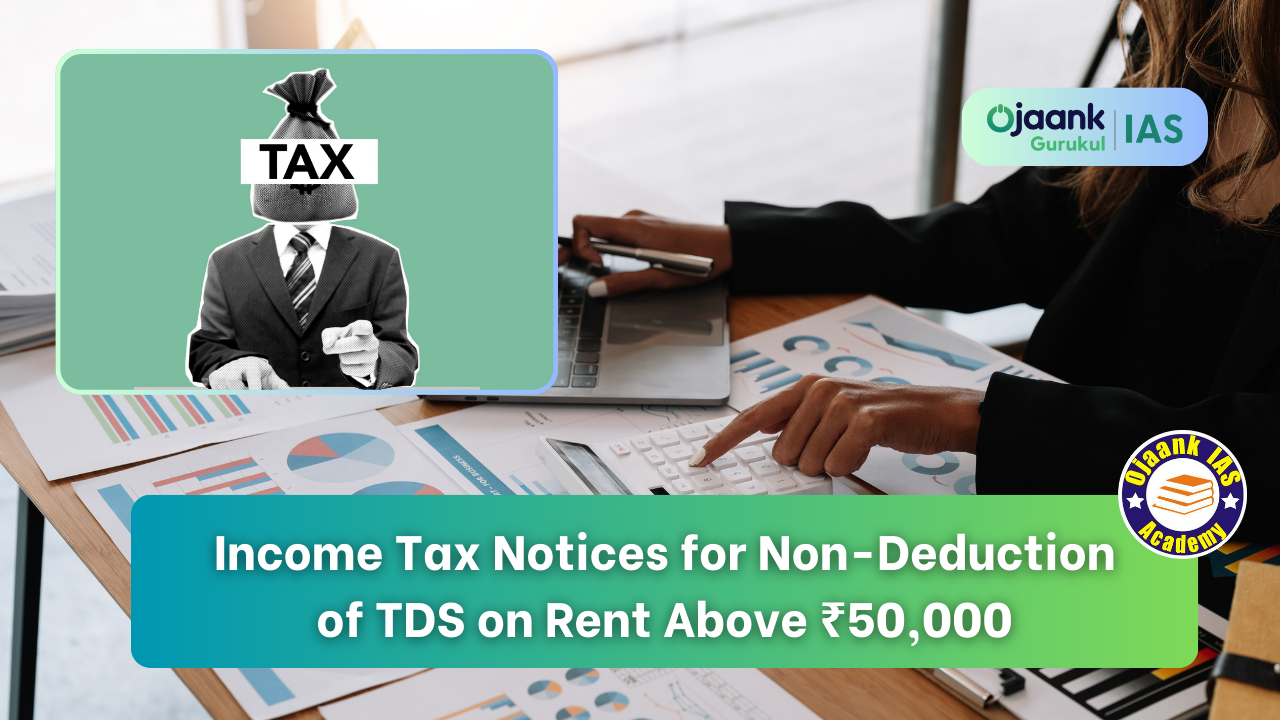Income Tax Notices for Non-Deduction of TDS on Rent Above ₹50,000

 Blogpost Outline:
Blogpost Outline:
-
Introduction
-
Why Are Taxpayers Receiving Notices?
-
What Does the Law Say? (Section 194-IB Explained)
-
TDS Deduction Rate on Rent: Old vs. New
-
Who is Liable to Deduct TDS on Rent?
-
What Happens If TDS is Not Deducted?
-
Penalty, Interest, and Assessee in Default
-
Exemption Clause: Relief If Landlord Has Paid Taxes
-
Filing Updated Returns: An Opportunity
-
Best Practices for Tenants to Stay Compliant
-
Conclusion
 TDS on Rent Above ₹50,000: Why the Income Tax Department Is Sending Notices in AY 2023-24 & 2024-25
TDS on Rent Above ₹50,000: Why the Income Tax Department Is Sending Notices in AY 2023-24 & 2024-25
The Income Tax Department has launched a compliance drive by issuing notices to taxpayers who paid rent above ₹50,000 per month but failed to deduct TDS. This has caught many salaried employees and tenants off-guard, especially those who claimed House Rent Allowance (HRA) without complying with Section 194-IB of the Income Tax Act.
If you’ve received such a notice, this blog explains everything you need to know—why the notice was issued, what the law mandates, possible penalties, and what you can do right now to fix it.
🌐 Read: Income Tax Department's TDS Compliance Drive – Learn why taxpayers are receiving notices on the official Income Tax Department website.
 Why Are Taxpayers Receiving Notices?
Why Are Taxpayers Receiving Notices?
Many individuals claimed HRA during the assessment years 2023-24 and 2024-25 while paying rent above ₹50,000 per month—but did not deduct and deposit TDS as required by law.
The Income Tax Department’s data-matching tools flagged this mismatch between HRA claims and TDS compliance, triggering automatic notices.
🌐 Learn more: IT Department Issues TDS Notices for Rent – Livemint report on how HRA and TDS mismatches triggered the notices.
 Section 194-IB Explained: What Does the Law Say?
Section 194-IB Explained: What Does the Law Say?
As per Section 194-IB of the Income Tax Act:
“If an individual or HUF (not liable for audit) pays rent exceeding ₹50,000 per month, they must deduct TDS at the rate of 5% (now 2% from October 2024) before making the payment to the landlord.”
-
TDS should be deducted once in a financial year (usually in March or at the time of termination of the lease).
-
The deducted amount must be deposited using Form 26QC and a TDS certificate (Form 16C) should be issued to the landlord.
 Old vs New TDS Deduction Rates
Old vs New TDS Deduction Rates
| Time Period | TDS Rate on Rent | Monthly Rent Threshold |
|---|---|---|
| Before Oct 2024 | 5% | ₹50,000+ |
| From October 2024 | 2% | ₹50,000+ |
This new rate reduces tenant burden but doesn't eliminate the requirement to deduct.
🌐 Read: TDS Rates Comparison: Old vs. New – ClearTax article covering the old and new TDS rates on rent.
 Who Needs to Deduct TDS on Rent?
Who Needs to Deduct TDS on Rent?
-
All individuals or HUFs (not required to get their accounts audited) paying monthly rent of ₹50,000 or more.
-
Applies whether or not you're self-employed or salaried.
-
The tenant is responsible, not the landlord.
🌐 Learn: Who Should Deduct TDS on Rent? – Taxmann explains who is responsible for TDS deduction on rent payments.
 Consequences of Non-Deduction: You’re an “Assessee in Default”
Consequences of Non-Deduction: You’re an “Assessee in Default”
Failure to deduct and deposit TDS makes the tenant an assessee in default, leading to:
-
Interest Penalty: 1%–1.5% per month
-
Late Filing Fee: Under Section 234E
-
Demand Notices
-
Potential prosecution in extreme cases
 Exemption Clause: Relief if Landlord Paid Tax
Exemption Clause: Relief if Landlord Paid Tax
There’s one key exception that can save you:
If your landlord has declared the rental income and paid due taxes, and you can furnish proof, you may not be treated as an assessee in default.
However, this depends entirely on:
-
Landlord’s cooperation
-
Proof of tax paid on rental income
-
Filing of return by the landlord
 Many landlords may hesitate to share such confidential information—so don’t rely on this clause blindly.
Many landlords may hesitate to share such confidential information—so don’t rely on this clause blindly.
 Updated Return Filing: Your Safe Exit
Updated Return Filing: Your Safe Exit
If you've received a notice and realize your mistake, you can file an updated return (ITR-U) under Section 139(8A), reduce your HRA claim, and pay the due tax and penalty. This is a golden chance to avoid further consequences.
Deadline for updated return:
-
24 months from the end of the relevant assessment year
 Act now if you haven’t yet!
Act now if you haven’t yet!
🌐 Learn: How to File an Updated Return (ITR-U) – Official IT department guide on filing an updated return under Section 139(8A).
 Tips for Tenants: How to Stay Compliant
Tips for Tenants: How to Stay Compliant
-
Always check your rent amount – If it crosses ₹50,000/month, TDS is mandatory.
-
Deduct TDS once a year – At the end of tenancy or financial year.
-
File Form 26QC and issue Form 16C to landlord.
-
Consult a tax expert if unsure.
-
Maintain records of payment, TDS deduction, and landlord details.
 Conclusion: Better Safe Than Sorry
Conclusion: Better Safe Than Sorry
The recent wave of income tax notices is a wake-up call. Paying rent above ₹50,000/month without deducting TDS can land you in serious trouble. The rules may seem technical, but they’re non-negotiable.
🌐 Learn more: Tips to Ensure TDS Compliance – Financial Express article with essential tips for TDS compliance.
 The best way forward? Comply proactively, file updated returns if needed, and keep yourself TDS-compliant.
The best way forward? Comply proactively, file updated returns if needed, and keep yourself TDS-compliant.
Remember: When it comes to taxes, ignorance is not bliss—it’s expensive.